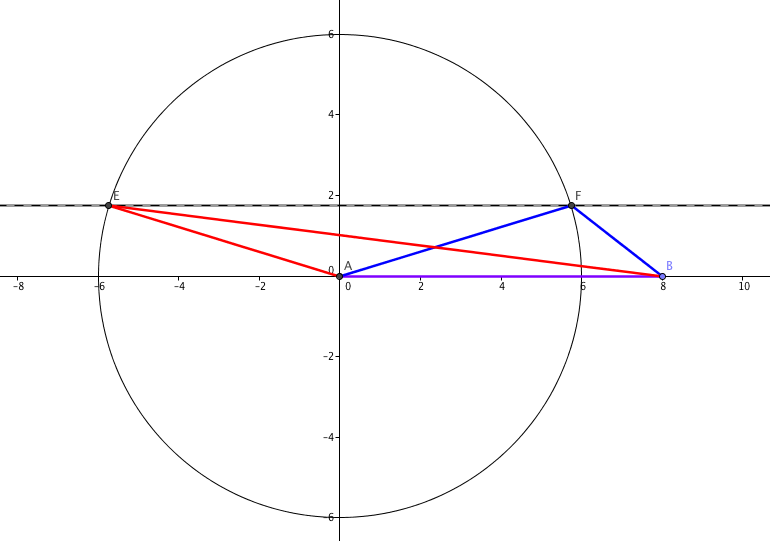Heroic triangles
In a recent Maths Challenge, students were told the area of a triangle ($7$cm$^2$) and the length of two of its sides ($6$cm and $8$cm), and asked how many possible lengths there were for the third side.
It’s easy enough to show there are two: let the base of the triangle $AB$ be the $8$cm side (purple). If the area of the triangle is $7cm^2$, the height of the triangle needs to be $\frac{7}{4}$cm (which is less than $6$cm); draw a line parallel to the base, $\frac74$cm away from it (the dashed line) and draw a circle with radius $8$cm centred on one end of the base. Where the circle and line cross (at $E$ and $F$), you have a possible apex for your triangle.
However, my student misunderstood the question and thought she needed to find the possible lengths of the third side. That’s a substantially harder question - especially in a non-calculator exam! However, it is possible - and you can get an exact answer. It’s just tricky.
I need a Hero, holding out for a Hero ‘til the end of the night
You need to use a formula for the area of a triangle you may not have seen before, known as Hero’s formula. If the sides are $a$, $b$ and $c$:
$Area = \sqrt{S(S-a)(S-b)(S-c)}$, where the semiperimeter $S = \frac{a+b+c}{2}$
Let’s let $a=8$ and $b=6$. To make the sums a little easier, I’m going to call our missing side $2x$ - because that makes the semiperimeter a nice, manageable $S = 7+x$.
The right hand side of Hero’s formula looks awful, but it simplifies quite nicely: $S-a$ works out to be $x-1$; $S-b = x+1$, and $S-c = 7-x$.
So, squaring both sides and putting in 7 for the area: $49 = (7+x)(x-1)(x+1)(7-x)$.
Do we have to multiply that out?!
Yup. Luckily, it’s easy if you spot you can use difference of two squares. $(7+x)(7-x) = 49 - x^2$, and $(x-1)(x+1) = x^2 -1$.
That means we’ve got something a bit more manageable:
$49 = (49 - x^2)(x^2 - 1)$
That, we can multiply out:
$49 = 49x^2 - 49 - x^4 + x^2$, or (rearranging) $x^4 - 50x^2 + 98 = 0$
Oh no! It’s a quartic! These can be solved, in general, but we don’t need Cardano’s crazy formulas for this one, it’s a quadratic in disguise: we can just let $y = x^2$ to turn it into:
$y^2 - 50y + 98 = 0$
Sadly, that doesn’t factorise, but you can complete the square and solve the traditional way:
$(y-25)^2 - 625 + 98 = 0$
$(y-25)^2 = 527$
$y - 25 = \pm \sqrt{527}$ ((The square root of 527 is a smidge short of 23, of course. Off by about $\frac{1}{23}$, since you ask, so it’s $22.96$ or so.))
$y = 25 \pm \sqrt{527}$
However, we made $y$ up - it’s really $x^2$:
$x = \sqrt{ 25 \pm \sqrt{527}}$
And our side length is double that:
$x = 2\sqrt{ 25 \pm \sqrt{527}}$.
Obviously, you’d use a calculator if you had one - I certainly did - but the Mathematical Ninja probably wouldn’t. He’d say that $y$ was roughly $2.04$ or $47.96$, and take the square root to get something a bit more than $1.4$ and something a bit short of $7$ (it’s closer to $4\sqrt{3}$), making the side length a little more than $2.8$ or slightly short of $14$, both of which fit with our pictures! (The answers are 2.86 and 13.85, which isn’t too shabby for work in our heads).
Does it work for all triangles?
A natural question for a mathematician: can you use the same technique to answer all questions of this kind? The answer, surprisingly, is yes - as long as solutions exist! If you let $m$ be the mean of the sides you’re given ($m = \frac{a+b}2$)and $d$ be half the difference between them ($d = \frac{a-b}{2}$), the quartic ends up being $x^4 - (m^2 + d^2)x^2 + (A + m^2d^2)=0$, where $A$ is the area.
If you were so inclined, you could work out a general formula for $x$- but I’ll leave that as an exercise!
